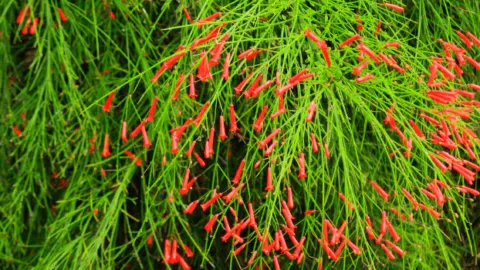The Firecracker plant goes by several names including Fountainbrush, Coral Fountain, Fountain plant, and the species name, Russelia equisetiformis if you want to believe the University of North Florida.
Some even say that these plants are ferns, though this isn’t true.
Regardless of which name you choose, they all share quite a unique physical characteristic.
These individuals are known as bushy subshrubs, where they tend to spread out a bit.
They have very narrow green leaves with bright pink or yellow flowers that are tube-like.
These blooms are where they get their name. The flowers resemble something similar to what you’d see at a firework show!
Firecracker plants bloom year-round according to the University of Florida.
With such a bright pop, these plants have quickly become a staple for those wanting a change.
They’re naturally found within the tropical regions of Guatemala and Mexico.
You might think that replicating this environment could be tricky, but it’s really not!
They only have a few requirements that need to be met in order to stay happy.
Beyond that, they are simple houseplants to keep in a pot.
Firecracker Plant Care
To care for a firecracker plant place it in the well-draining potting soil of your choice. It thrives in bright to full sun and temperatures between 65 to 75 degrees Fahrenheit (18 and 24 degrees Celsius). Water once a week. Humidity between 30-40% is sufficient. Fertilize every two weeks using a liquid fertilizer in Spring and Summer.
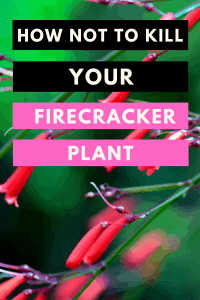
Firecracker Plant Care
Table of Contents
FIRECRACKER PLANT BASIC CARE INSTRUCTIONS
The overall maintenance for a Firecracker plant isn’t all that challenging if you know about the basic essentials.
These individuals have been kept outside in planters, but that may be a bit tedious, as they should be brought in during the winter months.
Keeping them as an indoor plant can allow you to bypass all of that! So, without further ado, here are the ways in which to keep your Firecracker plant popping!

Firecracker Plant Care
SOIL
Firecracker plants tolerate a variety of soils as long as they are well-draining.
Something to note with the Firecracker plant is that they can handle a wide variety of soil types without being compromised.
You could have anything from sandy, chalky, loamy, maybe even clay and they would continue to thrive.
Even their pH level can range, though they do tend to prefer between alkaline and acidic.
Some owners have suggested that these plants be covered with a thin layer of organic material such as peat hummus.
It can simply be added to the top layer of soil.
Another aspect to consider is if the soil is able to drain properly.
This will avoid problems later down the road.
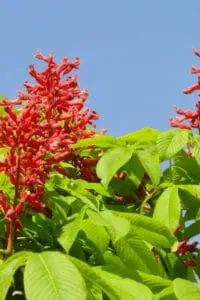
Firecracker Plants can be grown in a variety of soils as long as they are well-draining
LIGHT
Place your Firecracker plant into a spot that gets bright light to full sun.
Guatemala and Mexico are known for being quite warm, and getting plenty of sun.
Your indoor flora will want you to replicate these conditions.
South-facing windows tend to get more sun exposure than west or east-facing ones.
Can’t do this? Don’t worry! These plants have been known to thrive even when placed in an area of the house that gets partial shade.
The only drawback would be that Firecracker plants don’t tend to bloom as often without that added bit of sunshine.
We have an article that explains the different levels of light and how much plants depend on this aspect of care.
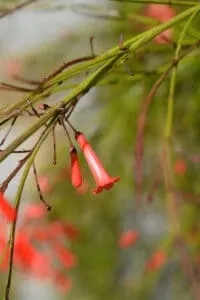
Bright direct light is best for a Firecracker Plant
WATERING
Water a Firecracker plant once a week.
Giving your Firecracker plant the proper amount of water is key to having a happy, vibrant individual.
Although drought resistant upon maturity, these evergreens would prefer to be given frequent watering sessions.
In fact, it is extremely important to keep up a routine regimen for younger plants, as they need to be kept moist in order to live.
Once reaching older years, they won’t require as much hydration.
This doesn’t mean that you should allow them to go too long without water. They still need a good bit of moisture.
But, how much is the right amount? Generally speaking, most Firecracker plants do well when given water on a weekly basis.
This can change depending on a few variables such as temperature, humidity, and what they are grown in. We’ll cover this in a later section.

Firecracker Plants need to be watered about once a week
TEMPERATURE
The ideal temperature for a Firecracker plant is between 65 and 75 degrees Fahrenheit (18 and 24 degrees Celsius).
As far as temperature goes, these plants tend to enjoy a room that stays relatively warm.
Their native environment is known for inhabiting warmer areas of the United States, Mexico, and Guatemala.
Firecracker Ferns are often grown outdoors, but this sometimes isn’t conducive.
Those plants need to be brought in during the colder months to keep them from withering away and falling off.
The room in which your fern-like subshrub resides should be kept anywhere between 65 and 75 degrees Fahrenheit (18 and 24 degrees Celsius).
There have been a few debates over what they can handle in terms of cold temperatures.
You should try to keep the room’s overall temps above 55 degrees Fahrenheit (12 degrees Celsius).
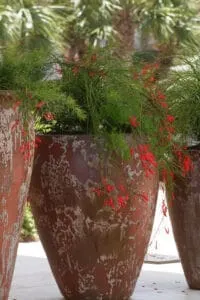
Firecracker plants grow in temperatures between The ideal temperature for a Firecracker plant is between 65 and 75 degrees Fahrenheit (18 and 24 degrees Celsius)
HUMIDITY
A humidity level of 30-40% is best for the Firecracker plant.
Remember us saying that these plants are drought-resistant. Well, that helps in the humidity category.
They’re happier overall with a bit more moisture, but that doesn’t mean that they can’t survive in lower levels of moisture.
If you want your flora to produce those long, colorful flowers, you’ll amp up the humidity.
You can do this in a few ways. The easiest and likely most commonly used technique is simply misting the leaves.
This is a great way of adding moisture. You just need to make sure that you aren’t adding too much moisture.
Watering on top of increased humidity can cause the leaves to fall off and die.
This is why we may suggest the second method. Placing your potted Firecracker plant on top of rocks in a saucer allows water in the container to evaporate.
It might sound complicated, but it is actually quite simple! And better yet, you don’t have to worry about the roots of your Firecracker plant being waterlogged.
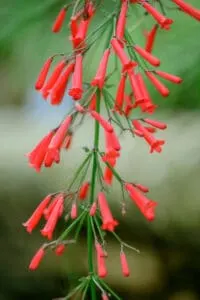
A Firecracker Plant doesn’t need a lot of humidity to be happy. 30-40% is sufficient
FERTILIZER
Fertilize a Firecracker plant every two weeks in spring and summer using a liquid fertilizer.
The use of fertilizer is key when you want to have those vibrant flowers. Sure, they aren’t large, but there are lots of them.
By adding fertilizer, you will give your plant the necessary nutrients to produce these blooms.
Compared to other houseplants, you can add quite a bit of fertilizer.
Most recommend that you give them food every other week during the correct seasons, spring and summer.
The liquid solution should be diluted by at least half strength.
You won’t need to add fertilizer during the colder months since these plants have a dormant period.
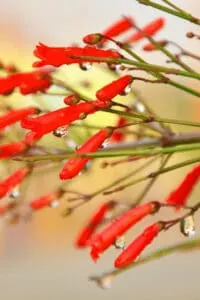
These plants like to be fertilized every 2 weeks in the growing season
PROPAGATION
There are a few ways that you could go about propagating your Firecracker Fern plant.
The majority of them are relatively straightforward. More common techniques include division, stem cutting, and layering.
Another strategy is to gather the seeds for future planting. This type of propagation requires that you keep the plant at a certain temperature and humidity.
To give you the option to pick between the different options, we will discuss the steps involved the easier of the two, stem cuttings.
GROWTH
These plants are relatively quick in terms of their growth rate. They tend to reach an overall height of three feet.
For width, they will spread out to about five feet in width.
Their stems tend to grow outwards with an arching pattern. Interestingly enough, these stems start out rigid and then become lopsided over time.
You may not want to have such a wide houseplant.
If this is the case, don’t fret! Pruning is a great way to control the size and shape of your Firecracker plant. Actually, this is key in the overall maintenance and health of your individual.
We will have a section later on regarding how to correctly prune a Firecracker plant.
POTTING
It’s a given that most plants with a pretty quick growth rate will need to be transferred to another container or pot every so often.
The roots of a Firecracker plant need to be able to spread out whilst the plant is growing.
This can’t happen unless they are given the appropriate sized container.
When you go about transferring it, be mindful of the root ball. It is crucial that you don’t damage this part of the plant.
Repotting itself should be done at the beginning of the year with a fresh supply of rich soil waiting for it in the new pot.
Transfer your Firecracker Fern plant annually for the best results!
PROVIDING YOUR FIRECRACKER PLANT WITH WATER
These plants need to have a consistent regimen when it comes to being watered.
They are considered to be drought-tolerant, but that doesn’t excuse someone who will simply water them once a month.
Those vibrant flowers won’t show up without at least the minimum requirements being met.
But, how much water is enough? And is there a chance of overwatering?
The frequency and amount of water will depend on the life stage of your Firecracker plant.
Younger individuals need to be kept voice nearly year-round. Older individuals don’t need to be given as much moisture.
The top layer of soil should be allowed to dry out some. Watering once a week should be enough!
The only time that you’ll want to increase this volume is if your house is particularly warm.
Another reason would be if your plant is held in a container.
Still, give enough time between watering sessions so that the top layer of soil can dry out somewhat.
FIRECRACKER PLANT PROPAGATION METHODS
These subshrubs can be divided in a multitude of ways. There are some techniques that make the process a little easier.
Most agree that you can create a new individual through division, tip or stem cuttings, seed germination, and layering.
After careful research, we’ve determined that stem cutting is the best way to go about propagating your Firecracker Fern plant.
To take it one step further, we’ve listed the steps involved in this method!
PROPAGATION THROUGH STEM CUTTINGS
- You’ll want to prepare a pot with freshly laid soil before making any incisions.
- Look over your plant and find a section that has had consistently healthy growth. There should also be at least two leaves located on the farthest end of the branch.
- Use your clean, sharp scissors to cut it 6 inches below the tip of the plant.
- Remove any leaves aside from the two closest to the branch’s tip.
- Use the scissors again to make three-inch incisions on the bottom half of the branch so that it can properly grow.
- Place the newly cut individuals into a pot with three inches being exposed. At this point, you will want to give your plant a thorough watering.
- Add a plastic bag to the top of the plant to increase humidity and put it in a shady spot. Check back every few weeks and transfer to a larger pot when roots develop.
FIRECRACKER PLANT PRUNING ESSENTIALS
Shrubs, such as the Firecracker Fern plant should not go too long without being cared for.
If you don’t take the time to prune your individual, you’ll end up with a plant that takes over the house very quickly.
They are known for spreading out by about a foot or two. Not only do you want to prune your plants due to the overall aesthetic, but it has a bigger reason.
Flora that doesn’t get routinely cared for tends to die back.
The flowers and stems start to die off when not pruned routinely. So, how does one go about doing this in a safe manner?
Plants that are given ample water and fertilizer will need to cut back more frequently.
You should be careful about which time of the year you decide to do this.
We recommend opting for late winter as the plant is generally going through a state of dormancy.
This is where you can tackle any stems that have been lacking in overall well-being and rigidity. You can do this every winter season for the best results.
Another noteworthy aspect to consider is something that is known as “rejuvenation pruning”.
This action is more than just a simple trim here and there. It involves the removal of any limbs or branches that need to be removed entirely.
You can also complete a hard pruning where you take back the plant to a height of six to twelve inches.
FIRECRACKER PLANT PROBLEMS
Every plant owner understands that there are a number of problems that can happen along the way.
This may sound daunting, but it’s not all that tricky if you know what to look for! We’ve compiled a few of the most common problems as well as solutions to each!
PROBLEM #1: BROWNING LEAVES
The discoloration of leaves usually indicates that your Firecracker Fern has too much water. It can also mean that your plant doesn’t have proper drainage.
Before adjusting your watering schedule, make sure that the pot or container that houses your flora contains at least a few drainage holes.
PROBLEM #2: NO BLOOMS
Usually, a plant that doesn’t produce flowers is experiencing a multitude of problems dealing with fertilization, light, and water needs being met.
We suggest first looking at the amount of light that the individual is receiving.
If that doesn’t help, then you’re likely dealing with an imbalance in nutrients. Adding a diluted fertilizer will help this issue.
PROBLEM SIGN #3: DYING BACK
Although maybe not the main reason for a lack of growth, your Firecracker Fern does need routine pruning.
By not removing those dead or dying leaves and stems, the plant will stop blooming altogether.
You’ll want to first check on the basic needs of the plant. Are you giving it enough water, light, food?
If yes, then consider increasing the amount of pruning that you give to your Firecracker Fern throughout the year.
PROBLEM #4: SMALL DOTS ON LEAVES
They may be hard to see at first, but tiny specks that appear to be either red or black in color signify that your plant may have mites.
In the event of mites, you’ll want to hose down your plant and rid it of as many bugs as you can. Follow it up by using insecticide or neem oil.
For anyone curious about these pests and how to correctly go about removing them from your plant, look at our article about killing Spider mites!
5 TAKEAWAYS TO A THRIVING FIRECRACKER PLANT
Plants are relatively easy to care for when you take the time to care for their basic needs.
To keep things simple, we’ve listed a few of the most important!
- Don’t worry too much about the type of soil that you use, but include a bit of organic material at least on the top layer for better results!
- Provide enough water to saturate the soil, letting it dry out some between.
- Given their natural habitat, keep the temperature between 18 and 24 degrees Celsius, or 65 and 75 degrees Fahrenheit.
- The more sun that they can get, the better as long as it isn’t direct.
- The use of fertilizer that is diluted to half the strength is a great way to ensure that blooms are consistent.
FREQUENTLY ASKED QUESTIONS ABOUT FIRECRACKER PLANT
Is a Firecracker plant considered to be invasive?
These plants are indeed considered to be an invasive species. They spread out and take over the area’s resources. In some areas, such as Florida, they are able to naturalize.
Do Firecracker plants attract hummingbirds?
The flowers of a Firecracker plant are bright and tubular because they do in fact attract pollinators, such as the hummingbird. They can even draw in butterflies. Some houseplants can accomplish this by being placed in an open windowsill.
Are Firecracker plants poisonous?
Firecracker plants aren’t poisonous. Regardless, we still suggest keeping them out of reach from kids and pets.

Daniel has been a plant enthusiast for over 20 years. He owns hundreds of houseplants and prepares for the chili growing seasons yearly with great anticipation. His favorite plants are plant species in the Araceae family, such as Monstera, Philodendron, and Anthurium. He also loves gardening and is growing hot peppers, tomatoes, and many more vegetables.

